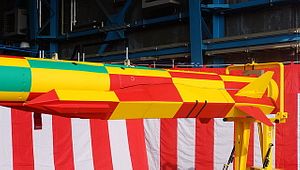With the venerable RGM-84 Harpoon growing rather long in the tooth, the U.S. Navy has begun searching in earnest for a new and cutting-edge anti-ship missile (ASM) in both air and ship-launched varieties. Unsurprisingly, the Navy has looked to further evolutions of two legacy weapons systems, the Tomahawk and Harpoon, to replace its fleet of 1980s-vintage weapons.
Of course, weapons procurement – especially for the world’s greatest maritime superpower – does not occur in a vacuum. While the Navy has distressingly neglected to construct new warships with organic Harpoon capability since 1999, China, Russia, and other adversaries have begun fielding advanced supersonic, long-ranged ASM like the SSN-27A Sizzler, the YJ-18, and other such weapons. America’s longtime technological and quantitative edge in wielding a “big stick” in the Asia-Pacific, then, is eroding at supersonic speeds.
Much has been written about the development of Lockheed’s Long Range Anti-Ship Missile (LRASM) and the possibility of fielding a competition between it and a next-generation Tomahawk modified for maritime attack. The Navy can and should encourage the development of these weapons, which maintain sophisticated capabilities like highly independent inertial navigation, data interlink, and in the case of the LRASM, a stealthy design for operation in an A2/AD environment. Their long range makes each choice, along with the Norwegian Naval Strike Missile, good options for increasing the range of U.S. ASM capability.
What these missiles have in survivability and range, however, they lack in speed. Compared to the Chinese and Russian missiles, the LRASM and Tomahawk are only capable of subsonic operation. This is precisely why the Navy should, in addition to procuring the LRASM/Tomahawk, move to collaborate with Mitsubishi Heavy Industries (MHI) and the Japanese Ministry of Defense, the developers of the XASM-3.
Procuring the XASM-3 is a tactical no-brainer for the Navy. Like the LRASM, it is a stealthy missile, yet unlike its American counterparts, its ramjet engine allows it to reach speeds in excess of Mach 3. This combination of speed and low-observability may prove decisive in a future A2/AD conflict, as the XASM-3 would be able to both evade sensors and outrun legacy defensive systems. Deployment with stealthy aircraft like the F-35 or B-2 would help mitigate its relatively short range of ~90 nm, but co-development between the U.S. and Japan on the missile’s propulsion could conceivably overcome this hurdle and also allow for ship-based deployment. Even at its current stage, the combination of ship-based LRASM and stealth aircraft-based XASM-3 deployment would represent an devastating fielding of stealth ASM capabilities.
This sort of collaboration is nothing new. Indeed, the defense-industrial bases of the U.S. and Japan have worked together closely for years, especially in missile development. Both the Patriot Advanced Capability-3 (PAC-3) and Standard missile have been jointly developed by American and Japanese firms, and the two countries have collaborated on other defense projects like the F-2 and F-15J. Notably, while Japan had for many years an informal prohibition on arms exports, this was modified expressly for the development of missile technology with the U.S.
While the Abe government has more explicitly lifted the arms export embargo, Japan has only won a single contract since – for the export of the Shin-Meiwa US-2 maritime patrol aircraft to India. A firm commitment on the part of the U.S. Navy and an industrial partner like Raytheon or Lockheed towards co-development and eventual procurement of the XASM-3 would provide tremendous encouragement to Japan’s artificially constricted arms sector, and would spur further loosening of the onerous export restriction regime. Further, with Japanese public opinion always lagging behind policymakers with regard to defense matters, both governments could market the deal as a job-creator and a further outgrowth of previous missile collaboration ventures.
While co-development and procurement of the XASM-3 makes sense both tactically and strategically, then, it would also prove to be a technological boon to the Navy. An agreement between the two governments would allow American defense industrial firms to peek into the propulsion technology of the world’s fastest ASM, and perhaps co-produce a land attack version of the XASM-3. Moreover, it would permit the Navy to develop advanced countermeasures and tactics to defeat supersonic ASM fielded by the Chinese and Russians.
With even its newest warships like the USS Zumwalt unable to field (already dated) ASM capability, the Navy’s traditional blue-water advantage in the Asia-Pacific is at risk. Submarines and aircraft alone cannot compensate for a lack of cutting-edge ASM technologies, especially in the face of the steadily mounting potential of adversaries to knock out Navy ships with fast missiles. While the Navy can and should move along with the LRASM/Tomahawk, MHI’s XASM-3 represents a unique intersection of technological superiority, tactical supremacy and strategic wisdom that make it a must-buy for the United States.
Ben Rimland is an MPhil student in modern Japanese studies at St. Antony’s College, University of Oxford, where I research American foreign policy in East Asia and Japanese defense issues.

































